Fesenjān or Khoresht Fesenjan is a warm hug from Iran in the form of a stew! Picture chicken or duck simmering in a velvety blend of ground walnuts and zesty pomegranate molasses sauce—a flavour fiesta adored worldwide! Trust me, if this deliciousness hasn't hit your taste buds yet, you're totally missing out!
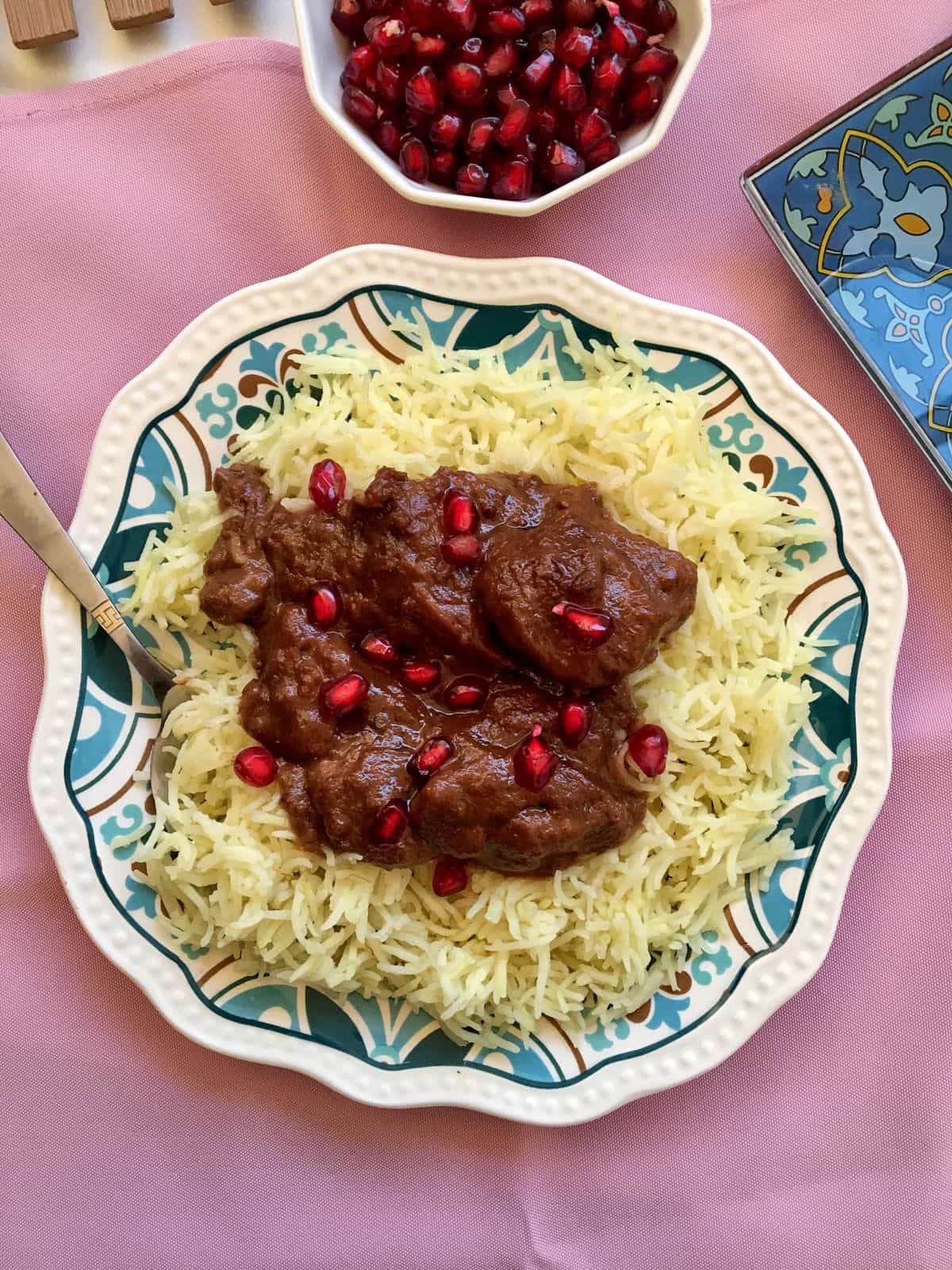
I love the fact that this dish involves just one chopping task— onions. As the stew finishes cooking, watch the chicken effortlessly melt into a luscious, thick gravy. We enjoyed this Khoresht Fesenjan served with saffron-infused turmeric rice and finished off with a slice of Persian love cake.
Jump to:
Let me share how I make this pomegranate walnut stew, a true Persian pride. You cannot rush into making Fesenjan for quick dinners. So resolve to make this only when you have ample time and know you will be serving hungry tummies!
Ingredients and Substituitions
Khoresht fesenjan, Khoresh-e Fesenjān, Fesenjan, and Fesenjoon are all the same dish - Persian Stew (khoresh) with walnut and pomegranate molasses. We cook chicken pieces in a butter-rich gravy, blending ground walnut sauce with dashes of salt and pepper for seasoning. Traditionally, Fesenjoon partners up with rice. 🍗🍚
- Chicken: Use skinless thighs or drumsticks. You may use duck or your favourite meatballs.
- Onion
- Walnuts
- Pomegranate molasses: You may use grape molasses with some pomegranate juice or in a pinch some tamarind paste and sugar.
- Butter and olive oil
- Water
- Ground spices: turmeric powder and black pepper powder
- Sugar
- Salt
Instructions
Here's a bite-sized recipe rundown:
- Brown chicken/duck pieces
- process walnuts to paste
- Sauté onions
- Add walnut paste, broth, molasses.
- Simmer meat in sauce
- Taste, adjust, and serve 🍗🍯🌰
Hint: Slow cooking is the key to developing the colour and taste of this stew. The walnut paste and molasses tend to stick or burn quickly, so stir the stew every 10 minutes. The result is a sweet and sour concoction that goes well with rice or bread!
Variations
You can make Khoresht Fesenjan without any meat - Vegetarian Fesenjen! The sauce is the star, so anything that goes great with walnut-molasses should be great. Here are some of my suggestions:
- Roasted eggplant chunks can bring a wonderful, smoky flavour and meaty texture.
- Cooked green or brown lentils are a protein-packed choice, adding a hearty element to your dish.
- Tender chickpeas can soak up all the rich flavours of the sauce, making for a delightful alternative.
Equipment
Here's what you need to whip up that delicious Fesenjan:
- A saucepot or a dutch oven
- a mixie grinder or food processor
Storage
Store leftover Fesenjan in an airtight container in the fridge. It'll stay tasty for about 3-4 days. When you're ready to enjoy, gently reheat on the stovetop or in the microwave. Add a splash of water if needed to maintain that perfect consistency.
Tip
If you have a bottle of molasses and are thinking about using it up, just add it in place of tamarind pulp. I have made South Indian tomato rasam, tamarind chutney, thakkali mulagittathu and even marinades. There are ample ways to incorporate pomegranate molasses into our Indian dishes so it is not a buy once and never use again thing.
So, next time you go to the supermarket, pick a bottle of Pomegranate Molasses and make Fesenjan!
Related
Looking for more recipes using pomegranate molasses?
FAQ
Khoresh-e Fesenjān sometimes spelt fesenjan or fesenjoon is a stew (khoresh) from Northern Iran where Persian pomegranates grow abundantly.
Walnuts in this Persian Chicken Stew recipe are a mandatory ingredient but if for some reason you want to replace walnuts with an alternative option, then my best guess would be to use pine nuts or pecans and lastly maybe hazelnuts. But I have not tested these options.
It is sour and tangy with a hint of sweetness, both flavours coming from tangy-sweet pomegranate molasses. The walnut paste adds a wonderful nutty taste and makes a rich sauce adding body and texture to the chicken stew. And the slow-cooked chicken gets soft soaking up all the flavour while rendering stock into the stew making it finger-licking good!
Pomegranate molasses also called dibis Ramman is a syrup derived from reduced pomegranate juice with or without sugar, into a thick, intensely flavoured syrup. You can easily use grenadine molasses instead. It is tangy and sweet like tamarind. Yes, Tamarind is the closest best alternative I can recommend but if you can only find grape molasses, then you can use that too. Always start adding a little and adjust as per taste.
Fesenjān is a rich dish that is often reserved for special occasions and is traditionally served over fragrant saffron rice or Tahdig. If making it for weekly dinner, you can serve this with some plain basmati rice or flatbreads.

📖 Recipe
Khoresht Fesenjan
INGREDIENTS
For the walnut paste
- 1 cup walnuts
- 2 tablespoons water
For the chicken stew
- 1 tablespoon unsalted butter
- 2 tablespoons olive oil
- 550 grams boneless chicken thighs pat dried
- 1 large onion chopped finely
- ½ cup pomegranate molasses
- 1 cup water
- ¼ teaspoon turmeric powder
- ¼ teaspoon black pepper powder
- 1 to 2 teaspoons sugar
- salt to taste
For garnish
- Pomegranate arils
INSTRUCTIONS
Prepare the Walnut paste
- Toast the walnuts until fragrant and let them cool.1 cup walnuts
- Transfer the walnuts into a mixie or food processor and pulse a few times until it resembles bread crumbs.
- Add some water and grind the paste until it lightens in colour. Keep this aside for later.2 tablespoons water
Prepare the Fesenjoon stew
- Heat some butter and olive oil in a thick-bottomed pot.1 tablespoon unsalted butter, 2 tablespoons olive oil
- Roast the chicken thighs until golden brown on all sides.550 grams boneless chicken thighs
- Transfer the chicken to a plate and keep it aside.
- Add the chopped onions and sauté until golden brown with a dash of salt.1 large onion
- Add the walnut paste, pomegranate molasses, water, turmeric powder, salt and pepper.½ cup pomegranate molasses, 1 cup water, ¼ teaspoon turmeric powder, ¼ teaspoon black pepper powder, salt to taste
- Drop the chicken pieces into the stew and season with salt.
- Add the sugar and bring the stew to boil on medium to high flame.1 to 2 teaspoons sugar
- Reduce the flame to low once it boils. Cover and cook for another 45 minutes to 1 hour stirring every 10 minutes until the stew develops a dark colour.
- Transfer to a serving plate and garnish with pomegranate arils. Serve with saffron or turmeric rice or any bread.Pomegranate arils
Notes
- Do not add too much water
- You may add a pinch of saffron to the finished Fesenjan stew.
- If making saffron rice, you may add a pinch of turmeric just enough to enhance the colour of the dish naturally without altering the taste. Saffron is expensive and it is better to use natural colouring than chemicals. It is okay to take saffron and turmeric together.
Recipe adapted from The Unmanly Chef.

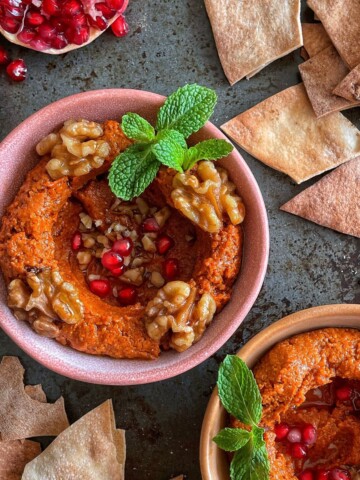
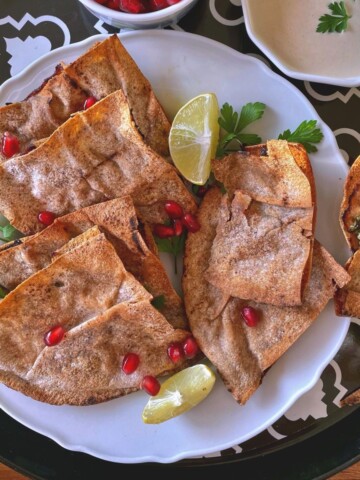

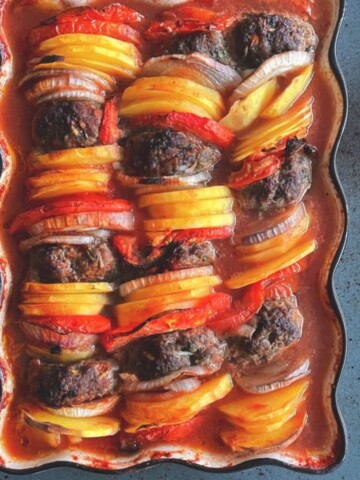

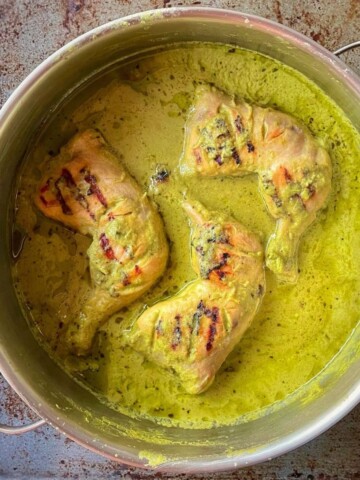
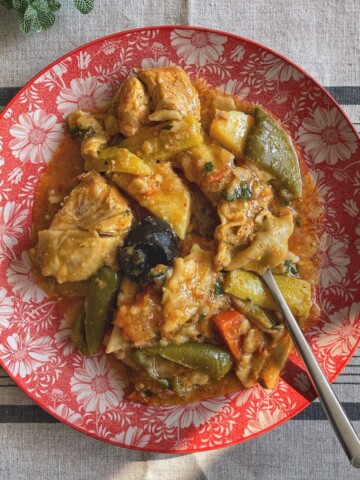
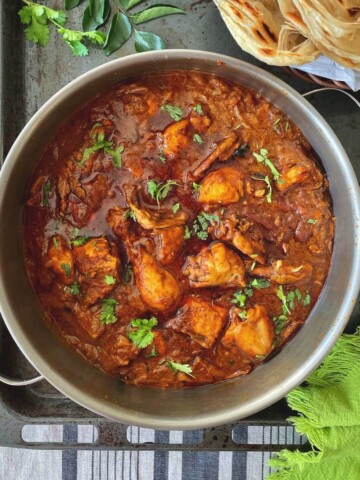

Comments
No Comments